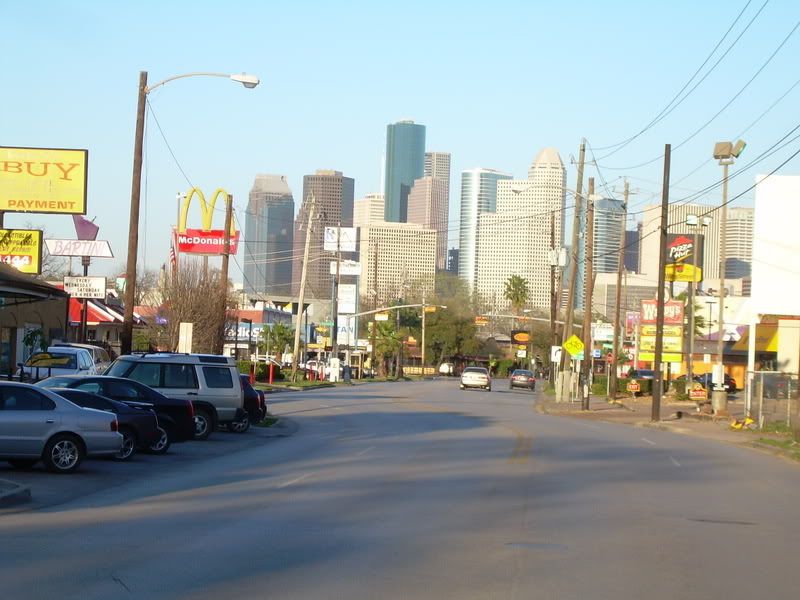
After we met with Dallas city officials we walked across the street to the hip sustainable aLoft Hotel. The building is a true example of adaptive reuse done the right way. The building was built in 1925 initially as a. Sante Fe railroad depot that once housed Haggar Slacks and the OK Paper Company. Devlopers Mr. Susah Naik, and partner Ted Hamilton are not rookies when it comes to developing hotels. Mr. Naik has been involved with developing hotels in Dallas-Fort worth for the past twenty years. Mr. Hamilton is the son of a developer with strong roots in Denver, CO. In addition to creating hotels Ted Hamilton also is the Chairman of the City of Dallas' safety committee.
Together they have been able to obtain a historic tax credits and received a 7 year TIF that totals in the amount of $4.2 million due to a City of Dallas commitment. The aLoft Hotel also received the Deal of The Year for 2009 from Preservation Dallas.
The shape of the building is not a perfect square and this created some design challenges. They managed to add a ninth floor creating 19 additional rooms for a total of 193 rooms and 11 meeting areas. Currently the aLoft Hotel has a average occupancy in the mid 60% with rates of $110. This is above the average competitors 50% occupancy rates in a down market. Online travel agents dominate the hotel market and cause rates to adjust daily across the industry. The in house sales team generates a salary and receives commissions on all the business they generate for the hotel This cost affects the operation expenses by 2% but improve the revenue by 30%. Past guest include the likes of entertainer Jaimie Fox and basketball NBA All Star DeWayne Wade.
The aLoft Hotel is a very refreshing place to be. The decor is very modern and the rooms are spacious with nice views. After the new convention center is complete the aLoft hotel will have positioned itself to capture potential guests seeking a lower rate for high quality for many years to come.
 When I arrived at Dallas City Hall I wondered how much natural light the building received. It appears to be greater than 80% thanks to the multiple large windows dominating both sides. The architect was well ahead of their time.
When I arrived at Dallas City Hall I wondered how much natural light the building received. It appears to be greater than 80% thanks to the multiple large windows dominating both sides. The architect was well ahead of their time.  Our first meeting was with Mr. Paul Dyer Director of Park and Recreation. Mr. Dyer discussed the importance parks. According to Mr. Dyer parks are vital in making cities more appealing for potential companies and homeowners. The development of parks or lack thereof can affect demand. Properties in decent proximity of parks will more than likely see increases in property value. Currently Dallas's Uptown and Downtown areas lack connectivity. The creation of a 6 acre park that bridges over the bustling Woodall Rogers Freeway (aka 75) will connect the two areas. This is part of the city's bigger plan to connect all corners of the 68 acre cultural district that consists of museums, restaurants, and residential towers, and performing art centers. Please note areas also include Fair Park and Deep Ellum.The City of Dallas was awarded $16 million in stimulus funds for the project, contributed $20 million of their own funds, and are also receiving private donations amongst others. The city did receive $30 million dollars for their Barnett Shale mineral rights and may renew the contract upon it expiration. No drilling has occurred to date.
Our first meeting was with Mr. Paul Dyer Director of Park and Recreation. Mr. Dyer discussed the importance parks. According to Mr. Dyer parks are vital in making cities more appealing for potential companies and homeowners. The development of parks or lack thereof can affect demand. Properties in decent proximity of parks will more than likely see increases in property value. Currently Dallas's Uptown and Downtown areas lack connectivity. The creation of a 6 acre park that bridges over the bustling Woodall Rogers Freeway (aka 75) will connect the two areas. This is part of the city's bigger plan to connect all corners of the 68 acre cultural district that consists of museums, restaurants, and residential towers, and performing art centers. Please note areas also include Fair Park and Deep Ellum.The City of Dallas was awarded $16 million in stimulus funds for the project, contributed $20 million of their own funds, and are also receiving private donations amongst others. The city did receive $30 million dollars for their Barnett Shale mineral rights and may renew the contract upon it expiration. No drilling has occurred to date. 
















































